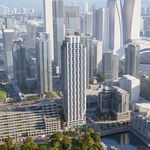That's how the TTC's TSP largely works too - only engaged if vehicles are late to increase reliability.
Metrolinx has indicated that the Crosstown will behave like this as well, if the trains are on time, they will not have priority, but will have priority if running behind schedule. It will mean longer travel times, but also should mean that the trains should run relatively on schedule. I.e. if they get held up at a light or two early on the surface run and are taking longer than they should be to get across the surface section, the last few lights will be prioritized to make sure they make the run in the planned time period.
I'm sympathetic to not having total light priority which would throw pedestrian and vehicular travel times way off, but think there should probably be some amount of normal priority for on-time vehicles. Something in between transit vehicles literally never seeing a red and having 0 priority absolutely whatsoever. Perhaps if vehicles are within 10-15 seconds of a light, the light gets extended.. reducing red-times, but not eliminating them.. My understanding is that this is largely how Kitchener's LRT operates - no total priority, but the LRVs are prioritized.




